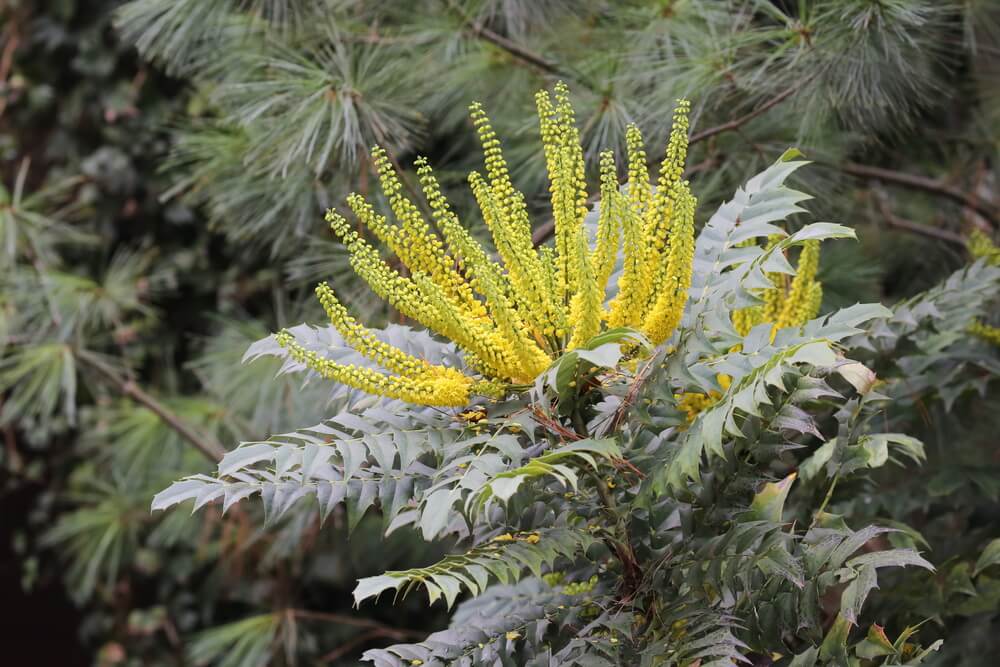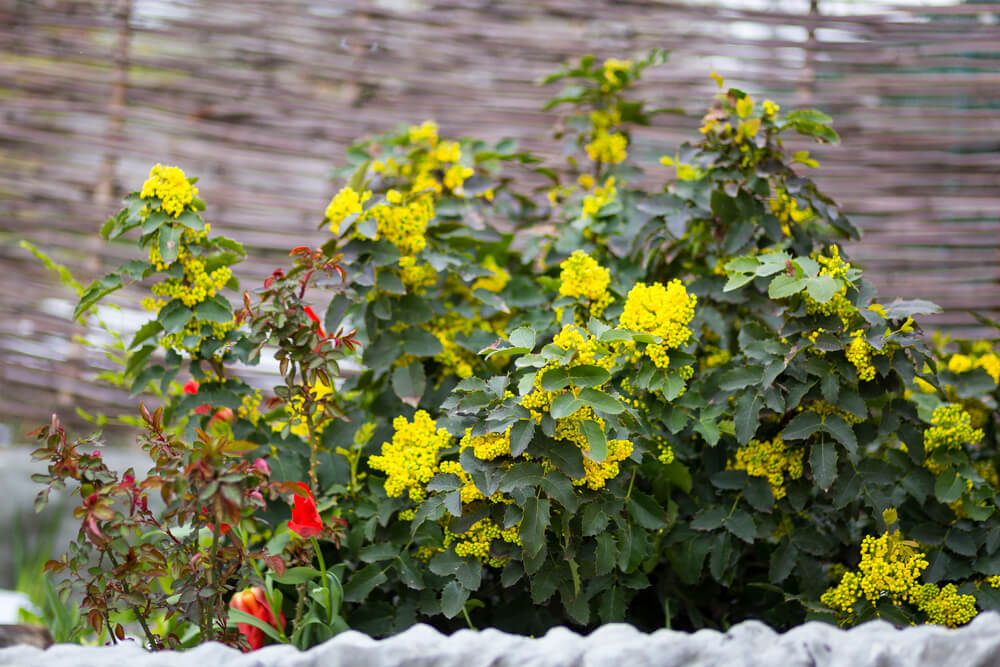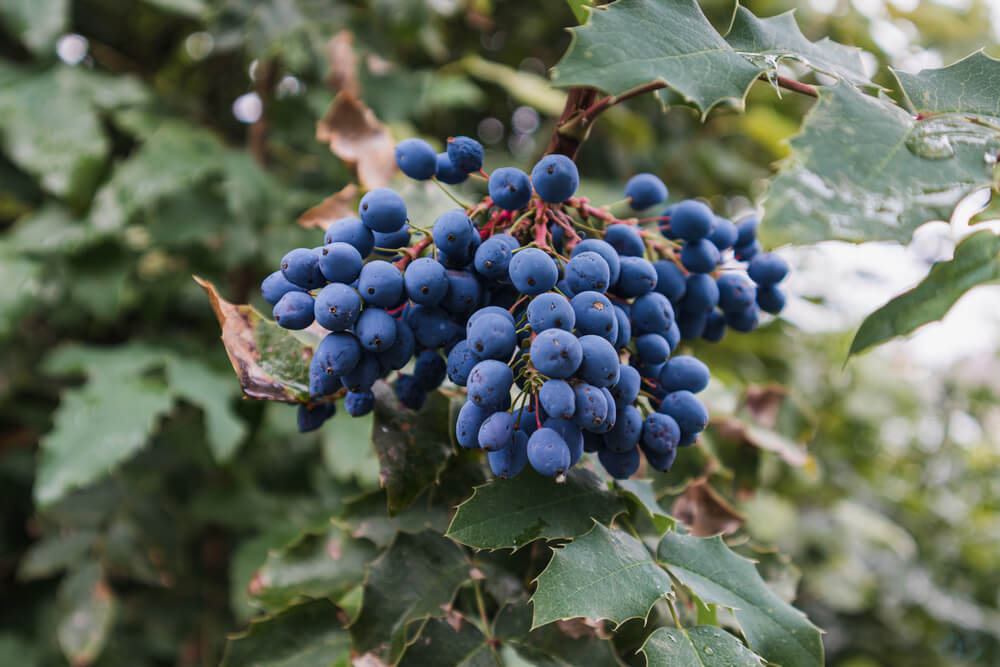Mahonia is a handsome plant with spiny leaves that change colors by the season. Yellow flowers blossom behind the glorious clusters in late winter, when a hint of color is like a breath of fresh air. Then come blueish berries, which birds love. It is not difficult to learn how to grow and care for Mahonia. So why not explore more?
Magnificent Mahonia
Lemony Mahonia flowers last a long time. They are one of nature’s gifts to bees, hummingbirds, and other pollinators. They precede the bushes’ dusky blue berries (somewhat like grapes). The flowers are edible but tart. The berries are best for jams and jelly. So you have a thing of beauty that doubles as part of garden-to-table cooking.
The prickly leaves of this bush make a relatively good barrier. They look impressive as a courtyard accent piece. Or, if you have a canopy of high trees, grow mahonia beneath them for more color and diversity and for creating levels for your space.
Key Takeaways
- Pruning is an ideal way to shape your mahonia.
- This beautiful bush has a secret. Its flowers and stems are edible.
- The mahonia needs deep watering in its first year of growth.
- Mahonias are very durable and adaptable.
8 Methods to Grow and Care for Mahonia
What Plants Are Similar To Mahonia: At first, you might well mistake the mahonia for holly because both have rich, green foliage with sharp serration. It also resembles barberry (and is part of that genus). However, holly berries are toxic, whereas barberries and mahonias are not.
1. Types of Mahonia
Mahonia, sometimes called the Oregon Grape, grows about 6 feet tall. It is most happy in the USDA zones 5-8. In considering Mahonia, think about the variety you might want.
- Charity: This mahonia reaches to the sky as if to embrace it at 15 feet tall. Line your property lines with them for privacy. USDA Zones 7-9.
- Creeping: This is a low shrub of about 1 foot tall. It’s great if you are looking for leafy ground cover.
- Fremont’s: an 8-foot tall mahonia. Most hardy in USDA zone 5.
- Marvel: Very fragrant flowers and large fronds. Blossoms late in the fall or early winter. The black berries appear come summer.
The main caution when placing your mahonia is keeping them away from walkways where their prickly leaves catch people unaware.
The UK imported mahonia in the 19th century from the US. The discovery of these bushes in Asia happened around the same time. One popular use for mahonia is as an architectural point of interest. The tall versions grow best in areas like parks, where their large size is an asset.

2. When To Plant
Mahonias aren’t terribly picky. You can plant them any time. You’ll get the best results, however, in the spring and summer. The soil is warm, moist, and welcoming. After you plant them, keep them watered, particularly if you have a dry spell. Be patient with your bush. It can take 10 years before they reach maturity.
Mahonia In the Yard
Your mahonia will appreciate full sun and well-drained soil. If you live in an area where you get frost, consider the Fremont variety. Look for places like long slopes or rock gardens for a life-long growing space.
Their tropical look might tempt you into setting the bush into a container and taking it indoors. This doesn’t lead to success because they require a spreading habitat. Have no fear; you’ll enjoy the backdrop that mahonia provides year-round.
Mahonia root is a powerful digestive assistant, improving the allover function of the digestive tract and helping promote a healthy appetite. This root decreases symptoms like diarrhea, bloating, gas, and nausea. It can clear parasites and toxins while multi-tasting as a natural antimicrobial that you can apply externally. Look for Mahonia Root Tincture at your local health food store or Farmicopia.
3. How to plant
There are some basics to planting your mahonia appropriately to keep it healthy. First, look around your yard at various times of the day. Mahonia enjoys both full sun and full shade, so if you can find a spot where it’s shaded during noon hours, that’s best.
In terms of soil, mahonia thrives in soil with organic matter. Try a 5-10-5 fertilizer to help with this. If you can integrate the amendment down into your soil about 8” before planting, you’ll get better results. Alternative fertilizing blends include slow-release balanced fertilizers (8-8-8).
Before placing the shrub in the ground, soak the root ball for 30 minutes. When new mahonia soil gets dry, water it deeply. Throughout the first year, it will be relatively thirsty. But never leave the soil mushy. The roots need drainage. If you’d like to water a little less, put mulch at the base of the mahonia. It retains water.
Mahonia bushes benefit from pruning. It’s a perfect way to shape the plant while removing leggy stems, dead leaves, etc. When you remove old canes, new ones typically grow. Just mulch around the shrub base afterward. You don’t have to do this often. If you wait until after the frosts pass, give it a light tidying and thinning every two years.
Don’t Move that Mahonia: Unless it’s a necessity, avoid transplanting your mahonia. They do not like it one bit. Avoid this by making sure you have enough space for the bush’s growth at the very beginning.

4. Mahonia Propagation
Take cuttings from your mahonia in late summer or early fall (before the bush flowers). Look for a 6-inch piece that looks semi-ripe. Take off the leaves from the top and the bottom of the cutting. Have some rooting hormone on hand. You’ll want to dust the end with it before potting. Find a container with good drainage and make sure the soil is moist. Keep it in a warm (NOT hot) area. Once roots emerge, it’s time to move the cutting to its permanent home in your yard.
This is the state flower of Oregon. Superstition says hanging a branch from the Mahonia on your doorway attracts luck and turns away those who would do you harm.
The shape of the bush’s berries or leaf colors predicted a mild or harsh winter. Unfortunately, texts conveying this bit of folklore do not expand on the idea further.
5. Wintering
Winter comes, and suddenly the leaves on your mahonia shine with green, orange, yellow, or red hues in the backdrop of light snow. You may spy tiny yellow petals on warmer days. The bush is cold-tolerant to about -20F, meaning you have little to worry about in terms of winter care, provided the plant has already established itself.
If you have young plants, cover them with horticultural fleece or even a plastic sheet before the first hard frost.
The Native Americans harvested the yellow Mahonia roots and turned them into dye. They applied it to wool or baskets, for example. To this day, the root continues as a natural dye for wool.
6. Common Pests and Diseases
If you see an early leaf drop from your Mahonia, you may have mealybugs, thrips, scale, or whiteflies. The foliage may also become distorted. Take a look at the leaves. Tacky, transparent spots are a secondary sign. Unfortunately, this substance encourages mold and/or fungus. Look for a horticultural oil and spray it on your plant.

Disease-wise, rust and powdery mildew show up as brown spotting on the foliage. They may cause some leaf damage, but they’re not fatal to your plant. Make sure you water at the base of your shrubs so the leaves don’t get damp. Rust, in particular, loves humidity and a lack of good airflow. Trim in the center of the bush to get some air circulation. If these changes don’t help, use a fungicide.
The Aroma of Mahonia & Berry Flavor: Mahonia smells a bit like the lily of the valley. If you try a little bite of a new berry, it’s very juicy but puckering TART. In a few seconds, that eases, and you can actually enjoy the mahonia berry’s flavor, which is somewhat rustic. Avoid the seeds, though. They’re even more bitter than your first nibble.
7. Common Problems with Mahonia
Mahonia responds to environmental stressors. Long, rainy seasons or dry seasons often result in leave curl or browning. Sometimes the leaves drop. Pay attention and adjust your watering schedule accordingly.
Mahonia Symbolism & Meaning: Folklore attributes Mahonia with great protective powers. A person could carry a small piece as a talisman. It not only acts as a defense against negative energies, but it also produces positivity.
8. Mahonia in the Kitchen
The best time to harvest mahonia berries is right after the first frost. The ice decreases some of the tartness. If you’ve ever had a red currant, it’s very similar. You can use mahonia similarly to currants, too.
Mahonia Berry Jelly

Rinse the fruit. Cover them (just barely)with fresh water and boil them until they burst. Use a fine sieve and get out the juice. If a bit of berry gets through, that’s fine. Just avoid the seeds.
Mix 1 tbsp water with 1 ½ tsp pectin per cup of juice. Warm the two together so the pectin dissolves. Add sugar, stirring until incorporated, then juice. Once the sugar dissolves, bring to a full rolling boil for one minute (if you have a thermometer, look for 220-222 F.) Pour into jars and leave them set up.
Tip: Try the resulting jelly on waffles and croissants.
Drink Your Mahonia
The Oregon grape mahonia has purple berries resembling (wait for it) grapes. Once made into syrup, you can create wine. When you are short on time, just add some to a sweet red or champagne, and enjoy.
The Lewis and Clark expedition discovered Mahonia in the North Western Territory of the US. The bush nestled comfortably in areas between the Pacific Ocean and the Rockies. A nurseryman, Bernard McMahon, out of Philadelphia, propagated the seeds. If you look closely, you’ll realize his impact on the name Mahonia.
8 Insights into Using Mahonia in the Landscape
With the right light and moisture, you can grow mahonia easily. Just pay attention to the weather and adjust your watering schedule. The colors of mahonia enrich the garden scape. Pollinators love it, meaning your other plants benefit, too. It’s okay to play with them in the kitchen or just enjoy them outside.
Frequently Asked Questions About Practices for Prolific Mahonia
Do mahonias like the sun?
Yes, but not 100% of the time. They don’t do well in full sun at the height of the day. So when you plant them, find a location that gets shade during those hours.
Why are the leaves on my Mahonia turning brown?
Pests and diseases can impact the way your leaves look. And they may even fall early. Over-watering and under-watering can also result in browning leaves. Examine your plant for any signs of pests or disease and also check the soil’s dampness.
Is Mahonia deep-rooted?
Mahonia has a deep taproot. From there, the plant’s roots extend outward. In some situations, the bush becomes invasive.
Where does mahonia grow best?
The USDA places mahonia in zones 7-9 with some wiggle room in zone 6. It needs moist (not west) soil and partial shade.
Can mahonia be cut back hard?
You can let mahonia grow without pruning. But pruning keeps shrubs shaped nicely. Hard pruning will not hurt your bush.
Does Mahonia lose its leaves?
No. Mahonia is an evergreen. While its growth slows in winter, it will not lose its leaves.



